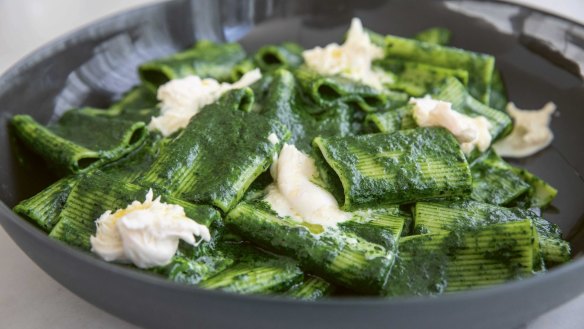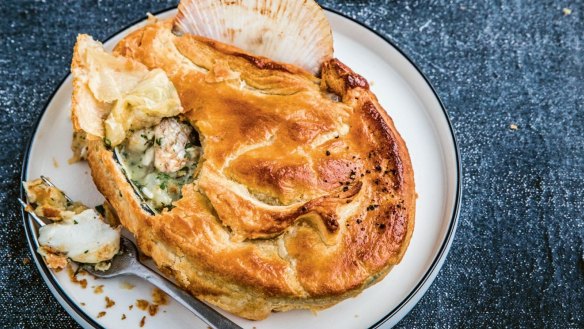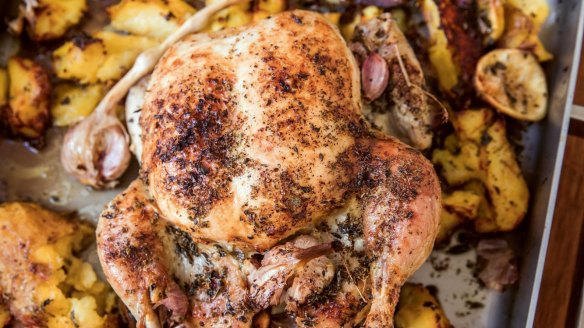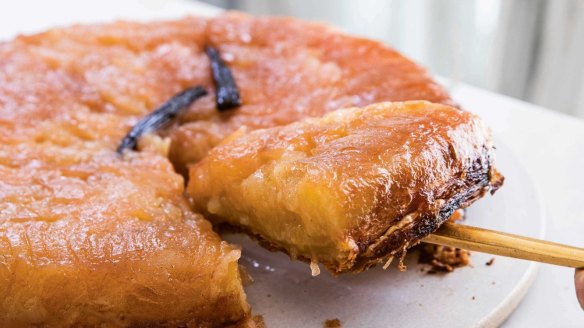Four recipes from Karen Martini's epic new recipe collection Cook

I set out to write a book that is all about how I cook and what I like to eat. It took more than five years – unpacking a cook's mind is not a simple task, actually somewhat terrifying to begin with!
Cook celebrates the strong fascination I have with many different cuisines and it houses my best-ever recipes from the simple to the elaborate, for all skill levels and occasions.
It's a book that will help those who are tentative about cooking while bringing texture, colour and flavour to more experienced cooks. Cook well and life is good.
Green aglio e olio
This sauce uses the principle of aglio e olio, with a deeply toasted garlic flavour infusing the oil-based sauce.
INGREDIENTS
- 150ml extra virgin olive oil
- 4 garlic cloves, peeled and halved
- 1 bird's eye chilli, sliced into rings
- 200g silverbeet, cavolo nero or kale leaves, without stalks, torn into small pieces
- 150g baby English spinach (or use half rocket)
- ¼ bunch of flat-leaf parsley, leaves picked
- 120g Parmigiano Reggiano or Pecorino Romano, finely grated
- 500g dried short pasta, such as penne, strozzapreti, casarecce, orecchiette or stracci, or fresh tagliatelle or paccheri
METHOD
- Add the oil and garlic to a small saucepan over a medium heat and cook until golden, about 6 minutes. Take off the heat, then add the chilli.
- Cook the silverbeet, spinach and parsley in a saucepan of boiling salted water for 2½ minutes, then drain briefly and chop roughly. Blitz in a blender, then add the oil, garlic and chilli with a few tablespoons of water and blitz until smooth, adding a little more water if needed to make a smooth sauce. Stir through the cheese, then season with salt and pepper.
- Cook the pasta in boiling salted water according to the packet instructions, until al dente. Drain, reserving a little of the pasta water.
- Heat the sauce in a large saucepan over a medium heat. Add the pasta to the pan with a splash of the reserved pasta water and toss through until the sauce clings to the pasta. Serve immediately.
Serves 4-6
Make it different
- With crunch. Sprinkle on some toasted walnuts or pine nuts to finish, or pangrattato.
- With cheese. Add torn burrata or stracciatella, or dollop with ricotta, and finish with chilli flakes.
- With another pasta. Instead of short pasta, serve the warmed sauce with ricotta gnocchi, ricotta and goat's cheese ravioli, ricotta and spinach ravioli or fresh pappardelle.

Fish pie
I make many versions of fish pie, from the humble to the decidedly fancy, but this is just about my favourite template. The sauce is so velvety, while the hot-smoked fish adds a warming note. I can't help adding some prawns, as I love them in pies like this – but it can simply be made with fish.
INGREDIENTS
- 75g unsalted butter
- 1 onion, diced
- 5 garlic cloves, sliced
- 1 fennel bulb, cut into 1cm dice
- 350g all-purpose potatoes (such as desiree), peeled and finely diced
- 800ml fish or chicken stock, hot
- 200ml pouring cream
- 200g smoked trout, flesh flaked
- 6 spring onions, white part only, cut into 3cm lengths
- 4 flat-leaf parsley sprigs, leaves chopped
- 4 dill sprigs, fronds chopped
- zest and juice of 1 lemon
- 600g small flathead fillets, or any boneless white‑fleshed fish
- 300g raw prawn cutlets, sliced in half lengthways
- 375g puff pastry, rolled and chilled (see recipe or buy)
- 1 egg, beaten
- extra virgin olive oil
METHOD
- Preheat the oven to 200C fan-forced (220C conventional).
- Melt the butter in a heavy-based saucepan over a medium heat. Cook the onion and garlic until softened, about 3 minutes. Add the fennel and potato, season with salt and pepper and cook for 3 minutes, stirring constantly. Pour in the stock and cream, bring to a simmer and cook for 20 minutes, until the potato is tender.
- Once cooked, blitz with a stick blender until smooth, then strain into a bowl. Add the trout, spring onion, herbs, lemon zest and lemon juice, season and set aside.
- Heat a large frying pan over a high heat for a few minutes. Toss the fish and prawns in a little oil, then sear in three batches, seasoning as you go, for a minute or so, to just colour but not cook through. Drain, then place in a 28cm pie dish (or use individual pie dishes). Pour the sauce over the top.
- Cut the pastry the same shape as your dish, but with a 3cm overhang. Brush the top edges of the dish with beaten egg, then drop the pastry on top. Decorate with any pastry scraps and cut some slits to release steam. Brush the pastry with egg.
- Bake for about 25 minutes, until the pastry is golden and the mixture is bubbling. Serve hot, garnishing with the shells if desired.
Serves 6

Brined roast chicken, Greek-style, with magic smashed potatoes
The emblematically Greek flavours of lemon and oregano are the ones I use most at home for both chicken and lamb, among other things. Taking the time to boil and squash the potatoes makes such a difference, as you expose the fluffy interior, allowing all those ragged edges to become golden and crisp, while the skins become glassy and crunchy.
INGREDIENTS
- 300g fine salt
- 3.5L (14 cups) water
- 1 × 1.6kg chicken
- 8 large, creamy yellow fleshed potatoes (such as Dutch cream), scrubbed
- 2½ tbsp dried Greek oregano (rigani)
- 1 onion, sliced 2.5cm thick
- 2 lemons, sliced
- 1 garlic bulb, skin on, cloves separated and smashed
- extra virgin olive oil
METHOD
- Dissolve the salt in the water, heating if necessary, but cool before adding the chicken. Immerse the chicken in the brine, making sure the cavity fills with the water. Weigh the chicken down with a plate to keep it submerged, then refrigerate overnight or for 12 hours.
- Once brined, drain and dry well. Refrigerating the chicken uncovered for a few hours or another day will yield very crisp skin, or just pat dry thoroughly and stand at room temperature.
- Preheat the oven to 200C fan-forced (220C conventional).
- Meanwhile, add the potatoes to a saucepan of cold salted water. Bring to the boil and cook for 20-25 minutes, until tender. Drain, then squash the potatoes so they split and flatten.
- Rub the chicken with oil. Sprinkle half the oregano over and season with pepper. Arrange the onion in a roasting tin to make a trivet, and crown with the chicken. Surround with the potatoes, lemon and garlic. Season the potatoes, scatter with the remaining oregano and drizzle with oil. Roast for 1 hour 10 minutes.
- Rest the chicken for 15 minutes before serving.
Serves 4-6 as a main
Make it faster
- You can skip the brining altogether and roast the chicken as is.
Make it different
- Boost the brine with drained sauerkraut, kimchi, olives or any other pickling liquid. Just replace 600ml of the water with whatever pickling liquid you have, then halve the salt in the recipe.

Tarte tatin
This is a classic tarte tatin, bursting with buttery, caramelised apple flavour. It's such a simple presentation, yet it takes my breath away every time I flip it over. And the scent of apples cooking in the house almost sends me into a trance – I find the aroma so soothing. This dish may seem a little intimidating at first, but it's really not hard to get a great result. A copper tarte tatin pan is perfect, or you can use any appropriately sized ovenproof pan with curved sides (and preferably with a removable handle). This recipe is rather special, as it's from my sister Odette, who is a fabulous pastry chef.
INGREDIENTS
- 400g quality puff pastry (see recipe or buy pastry)
- 200g chilled unsalted butter, finely sliced
- 200g caster sugar
- 1 vanilla bean, sliced on an angle (optional)
- 12 large granny smith apples
METHOD
- Roll out the pastry to about 1.5cm thick, then cut out a 30cm circle. Rest on baking paper in the fridge until required. (Always rest the pastry after rolling, and keep it chilled, otherwise it will shrink too much.)
- Line a 28cm ovenproof pan or copper tatin pan with the butter, smearing it to cover evenly. Evenly sprinkle over one-third of the sugar. Scatter with the vanilla, if using.
- Peel the apples, then cut the flesh away from the cores in cheeks. Slice about 5mm thick, fanning the apples into the pan as you slice, working in a spiral from the middle out, continuing until the base is covered and you have used half the apple.
- Sprinkle another third of the sugar evenly over the top, then fan the remaining apple slices around in the same fashion, finishing with the remaining sugar.
- Cover the apples with a circle of baking paper, then seal with foil. Place the pan over a low heat and cook for 45 minutes. The apples will cook and the sugar will caramelise very slowly.
- Near the end of cooking, preheat the oven to 210C fan-forced (230C conventional).
- Take the pan off the heat and remove the foil and paper. There will be quite a bit of liquid, which may seem odd, but don't worry. Cover the pan with the pastry, quickly tucking the overhang down the sides of the pan.
- Bake for about 30 minutes, until the pastry is golden. There will be syrup bubbling at the edges of the pan; it's important to let this set and be absorbed before trying to invert.
- Remove from the oven and stand for about 20 minutes, until the syrup has started to thicken.
- Cover the pastry with a serving plate larger than the pan, then gently flip the tart over. Serve warm or cold.
Serves 6-8
Pair with
- Whipped cream, ice-cream or vanilla creme anglaise.
Rough puff pastry
Rough puff and classic puff pastry work on a similar principle, with similar results, as both doughs are loaded with butter. As the pastry cooks, the water expands and tries to escape, while the fat in the butter stops the flour forming bonds and creating structure – so the pastry puffs, and you get these flaky layers enriched with butter. It's a gorgeous little reaction. The more layers you have, the flakier the pastry. With classic puff pastry, the butter is pressed into distinct layers between the dough, while rough puff simply incorporates everything together. With rough puff, you won't get defined layers, but you still get a flaky and buttery result, with less effort. It's a great place to start your puff pastry journey, and it's really not hard at all. However, it is very important to work quickly and with well-chilled butter. A hot kitchen or warm butter will mean you'll need to add too much extra flour, which will make the pastry heavy. Streaks of butter through the dough are exactly what you're looking for, so don't panic if it's not uniform. Remember, it's rough puff.
INGREDIENTS
- 500g (3⅓ cups) plain flour
- 1 tsp fine sea salt
- 400g unsalted butter, diced and well-chilled
- 2 tsp lemon juice
- 225ml water
METHOD
- Tip the flour and salt onto a clean bench, then top with the chilled butter. Chop through with a pastry scraper or large spatula until roughly incorporated. Make a well, then pour in the lemon juice and water. Combine quickly into a rough dough. If the dough is sticky, add a little more flour – but you shouldn't need to if working while the butter is still cold. Wrap in plastic wrap or place in a clean reused freezer bag and rest for 30 minutes in the fridge.
- With your hands, shape the rested dough into a rough rectangle, then roll out to about 30 × 40cm. Fold in three as you would a letter, ensuring that the pastry meets neatly at the corners. Wrap and rest for another 20 minutes in the fridge. Place the rested dough on the bench, with an open edge facing you. Roll out to 30 × 40cm, fold in three again, then chill again for 20 minutes.
- Repeat the process, chilling for another 20 minutes.
- The pastry is now ready to use. Alternatively, you can double wrap tightly in plastic wrap and refrigerate for up to 3 days, or freeze for 10-12 months. Thaw frozen pastry in the fridge for about 4 hours before using.
Makes about 1kg
This is an edited extract from Cook by Karen Martini. Photography: © Mark Chew. Published by Hardie Grant Books, RRP $100. Available in stores nationally from August 8. Order now
